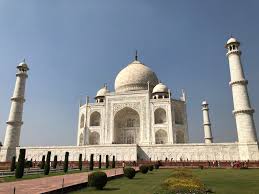Exploring the Taj Mahal: Marvel of Mughal Architecture

Introduction
The Taj Mahal, an ivory-white marble mausoleum located in Agra, India, is renowned across the globe as a symbol of love and an architectural marvel. Commissioned by Mughal Emperor Shah Jahan in memory of his wife Mumtaz Mahal, this UNESCO World Heritage site draws millions of tourists each year. Its significance extends beyond its aesthetic appeal; it represents a fusion of cultural traditions and has become an enduring symbol of India’s rich history.
Architectural Significance
Completed in 1653, the Taj Mahal showcases the exquisite artistry of Mughal architecture, which combines elements from Persian, Islamic, and Indian styles. The dome rises majestically at 35 metres and is surrounded by lush gardens and reflecting pools, designed meticulously to harmonise with the surrounding environment. The intricate work of marble inlay, known as pietra dura, adds to the monument’s beauty, featuring semi-precious stones that form intricate floral patterns and calligraphy.
Recent Developments
In recent years, the Taj Mahal has faced challenges due to environmental pollution and rising tourist numbers. Authorities have implemented measures to preserve the integrity of the monument, including limiting visitor access and introducing stricter pollution controls. A major restoration project launched in 2021 aims to repair weathered structures and enhance the site’s landscaping, ensuring the monument can be enjoyed by future generations.
The Impact of Tourism
The Taj Mahal attracts around 7 to 8 million visitors annually, making it one of the most visited monuments in the world. However, the influx of tourists also raises concerns regarding sustainability and the preservation of the site. Local officials are exploring ways to balance tourism with conservation, potentially introducing timed entry and increasing entry fees to manage the number of visitors effectively.
Conclusion
The Taj Mahal remains an iconic representation of love and artistic achievement. As efforts continue to protect and conserve this historic site, its enduring legacy will hopefully inspire future generations to appreciate the craftsmanship and historical narratives embedded within its walls. As one of the wonders of the world, the Taj Mahal not only reflects India’s cultural heritage but also highlights the importance of preserving such treasures in the face of modern challenges.









